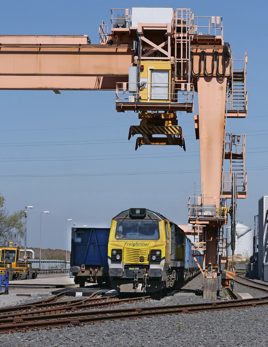Driving modal shift
Because carbon-intensive HGVs and vans make up 46% of emissions from road transport, modal shift is potentially the most promising way to dramatically reduce freight’s emissions.
The oldest lever to encourage modal shift is the Freight Facilities Grant (FFG) scheme, created under the 1974 Railways Act to fund new connections between running lines and terminals/sidings. Only in Scotland is it still in use, and although it is offered by the Welsh Government, there is no budget for the scheme in Wales.
FFGs provided match funding for up to 50% of the capital cost, and that was recoverable if the traffic did not materialise. Guy Bates, Head of Freight Development at Network Rail, sees scope for their revival with a different structure that would recognise the value of decarbonisation benefits.
“The capital upfront cost of a new main line connection can be hefty. NR/Great British Railways could either put the money in and charge a rent for the area that is being used, or we could discount the rent for a term so that the third-party is able to invest. This property-related mechanism would work unless the costs are too high ever to recover them through rent.
“Another approach is to look at socio-economic value, as we do for network enhancements today, which would be reflected in the business case for an injection of public money.
“What we have never done is to blend those two mechanisms by saying we can recover half the cost of a project through a long-term rental agreement and the other half through socio-economic benefit. If we did that, we could potentially have a tool to facilitate the realisation of the many more terminal facilities we need. Paying rent encourages use, too.
“The socio-economic tranche would be predicated on a certain amount of traffic arising in order to realise the anticipated socio-economic and environmental value. It would be subject to a claw-back if the traffic didn’t materialise and the public didn’t get the cleaner air they had paid for.
“The tools we need already exist - it’s a question of how we agree we are going to apply them in combination to best effect. Because they are in different spheres at the moment - one calculus for network enhancements and another for the property portfolio - they need bringing together to make it work.”
The Mode Shift Revenue Support (MSRS) scheme was introduced in 2010 to tip finely balanced flows of intermodal and bulk traffic in favour of rail in all three countries, and a 2020 DfT report recommended its retention subject to improvements. The grants total has never exceeded £20m a year and has been oversubscribed every year.
Maggie Simpson OBE, Director General of the Rail Freight Group, believes that even a small increase would “tip some flows into viability, such as Immingham-Doncaster International Railport, now with customer clearance for inland border checks, and some trans-Pennine and South West flows. A mechanism that pump-primed a new service and tapered as it becomes established would be helpful.”
Julian Worth, chairman of the Rail Freight Forum of the Chartered Institute of Logistics, sees the potential for immediate change: “These are established procedures, so we could simply increase the trivially small budget to see an effect in this financial year.”
Bates takes the view that we should also be enabling train operation in a way that is economically robust, helping by providing infrastructure, paths and facilities that allow freight operators to be competitive rather than merely subventing the operational status quo.
“Equally, there is mileage in how you play tunes with the rates of access you charge for traffic during defined trials and/or initial start-up periods,” he says.
“If there are some concessions for new-to-rail traffic while the operator is beginning to build commercial momentum, that would seem entirely appropriate. We are entitled to do this today, but to date it’s been ad hoc.
“We are looking at establishing a clear and administratively simple procedure with a view to stimulating the market, encouraging innovative new traffic on new axes by offering some critical initial commercial breathing space.”
One of the most interesting and positive initiatives recommended by the National Infrastructure Commission’s Better Delivery report has been the work by NR and National Highways (formerly Highways England) on the Solent to the Midlands Multimodal Freight Strategy, published in June.
Working with wider stakeholders, including the freight, transport and logistics industry and sub-national transport bodies, it looks at potential new markets for rail as well as investigating the scope for modal shift in food and drink, chemicals, secondary materials and waste, aggregates, mail and parcels.
For instance, a large percentage of cars and vans produced at Cowley, Halewood and Castle Bromwich are exported through Southampton Docks. But only a third of the cars exported through Southampton are delivered by rail, and none of the imported vehicles for distributors.
The analysis will help inform multi-modal investment decisions at a time when National Highways is increasingly concerned by the life-expired parts of the oldest motorways and keen to see a reduction in the heaviest stresses. The question becomes: which capacity enhancements cost less and deliver the greatest economic and environmental benefits?
Along with multi-modal studies goes the need for a changed mindset, both among logisticians accustomed to thinking solely of tyres and tarmac and among railway staff whose focus may have been exclusively on the betterment of the passenger railway. Some railway managers even regarded freight as compromising their performance targets for passenger trains, and so hindered its development.












